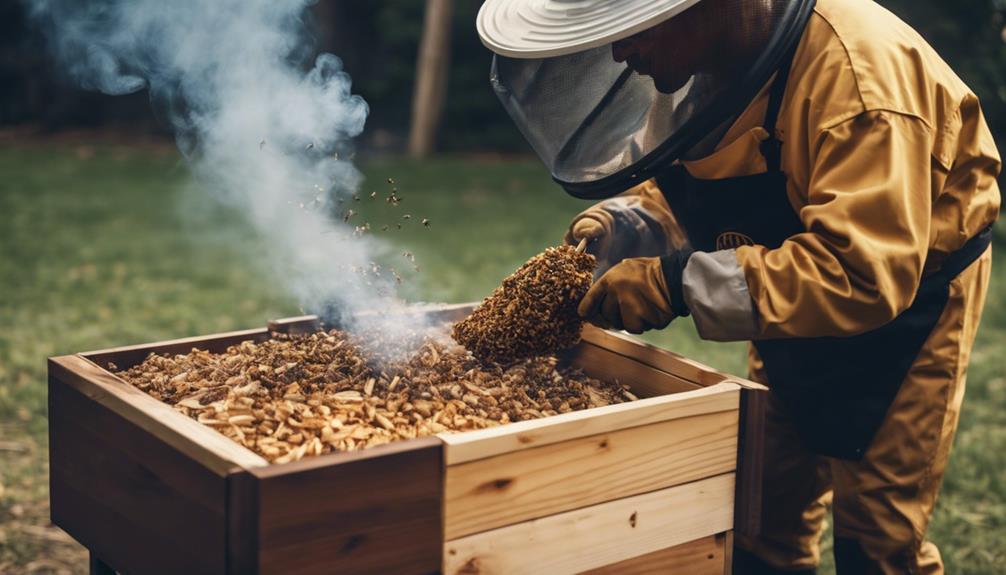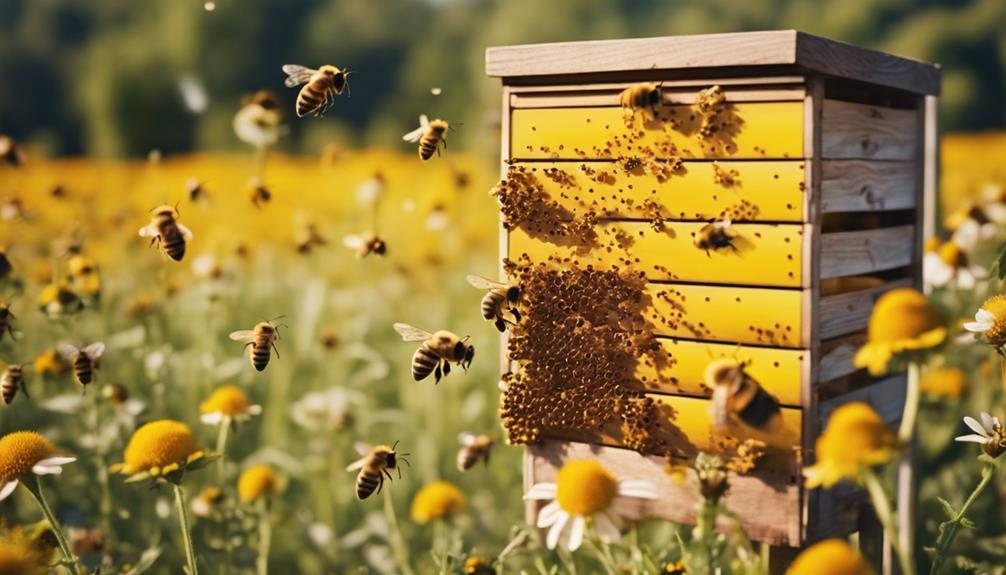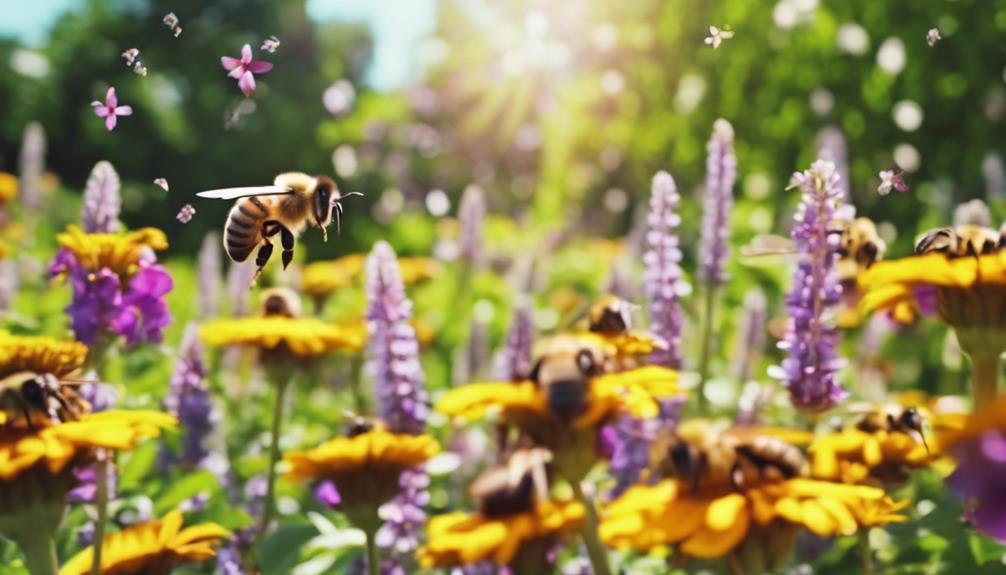Sure thing! Using wood chips in a bee smoker is a great idea. They offer a long-lasting burn, steady cool smoke, and even pleasant scents that can make beekeeping a breeze. Hickory, pine straw, oak, and apple wood are excellent options that provide different burn rates and flavors. Opt for untreated wood for safety, and you can even experiment with pine wood for a nice aroma. Mixing wood chips with other materials like pine straw or sawdust can help control the smoke temperature and intensity, allowing for a customized beekeeping experience. Overall, adding wood chips to your smoker can really enrich your beekeeping adventures!
Main Points
- Wood chips can be used in a bee smoker for long-lasting, cool smoke.
- Choose untreated hardwood chips like hickory for safety and aroma.
- Blend with materials like pine straw for varied smoke profiles.
- Properly pack the smoker with dry chips for consistent output.
- Maintain ventilation to control temperature and smoke intensity.
Benefits of Using Wood Chips
Using wood chips in a bee smoker offers several benefits that can significantly enrich the beekeeping experience.
Wood chips provide a vital and long-lasting burn, ensuring that the smoker remains operational throughout hive inspections. They play an essential role in maintaining a steady, cool smoke, important for calming the bees and preventing agitation during routine checks.
By incorporating wood chips like hickory or apple wood, beekeepers can infuse different pleasant aromas into the smoke, enhancing the overall ambiance of the hive.
The convenience and effectiveness of wood chips make them a popular choice among beekeepers for managing bee behavior. This controlled smoking environment not only benefits the bees but also contributes to a smoother and more enjoyable beekeeping process.
Types of Wood Chips to Consider
When selecting the appropriate wood chips for a bee smoker, beekeepers commonly consider various types such as hickory, pine straw, oak sawdust, and apple wood. These options offer different burn rates and flavors, allowing beekeepers to choose based on personal preferences and beekeeping needs.
It’s important to choose untreated wood chips to guarantee the smoke produced is safe for the bees and the environment. Pine wood chips can add a pleasant aroma to the smoke without being overpowering.
Experimenting with different types of wood chips can enrich the beekeeping experience, providing opportunities to discover unique combinations that work best for calming the bees during hive inspections.
Tips for Preparing Wood Chips

When preparing wood chips for your bee smoker, it’s important to choose the right type that suits your needs. Soaking the wood chips in water for better smoke production is a simple yet effective tip to keep in mind.
Additionally, adding more chips during use can help maintain a consistent and controlled smoking process.
Choosing the Right Type
For peak performance in a bee smoker, selecting hardwood chips like hickory, oak, or walnut is recommended. Opting for untreated, unpainted wood chips guarantees the safety of your bees. Hickory wood chips, known for their antibacterial properties and long-lasting burn, are a popular choice among beekeepers.
Additionally, homemade twigs can serve as a suitable alternative to store-bought wood chips. If you’re looking for another option, consider using aspen unscented gerbil bedding as fuel for your bee smoker. These choices not only provide efficient smoke production but also prioritize the well-being of your bees.
Experiment with different hardwood varieties to find the perfect match for your beekeeping needs.
Soaking for Better Smoke
To improve the quality of smoke produced in a bee smoker, consider steeping wood chips in water before use. When you steep wood chips, they smolder more slowly, creating a cooler and consistent smoke ideal for beekeeping.
This slower burn also guarantees a longer-lasting smoke, perfect for managing your bees without the need for frequent refills. Additionally, wet wood chips are less likely to ignite too quickly in the smoker, giving you better control over the smoke levels.
Adding Chips During Use
We often add wood chips to the bee smoker during use to maintain a consistent and cool smoke. Ensuring the chips are dry beforehand is essential for easy ignition and smoke production.
Soaking the wood chips before use can help in controlling the smoker’s temperature, offering a more controlled environment for the bees.
When the smoker needs a boost, adding a handful of wood chips on the burning fuel can improve the smoke output, aiding in keeping the bees calm and collected.
For a well-rounded fuel mixture, consider combining wood chips with other sources like burlap or grass to achieve an effective and balanced smoke.
Mixing Wood Chips With Other Materials
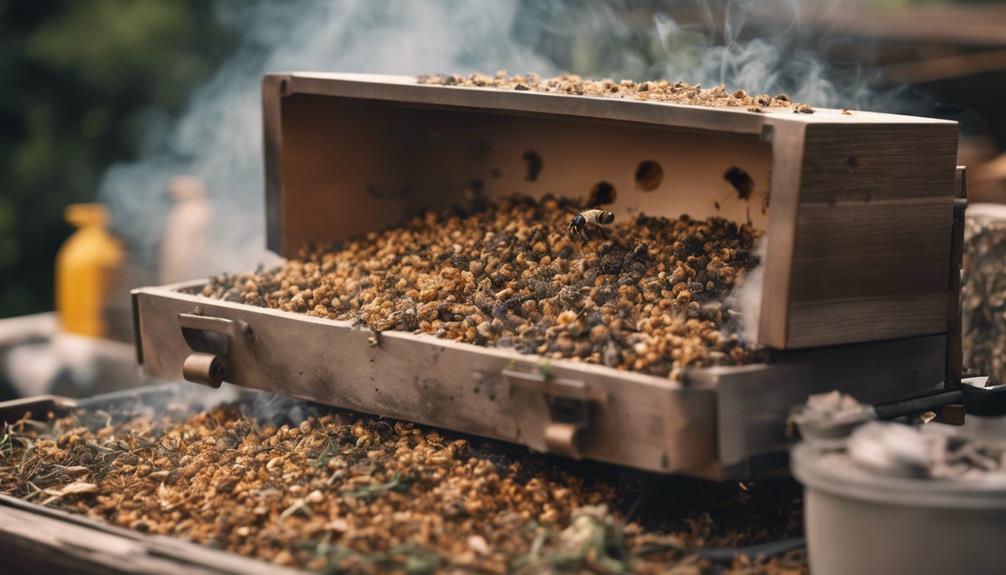
When preparing bee smoker fuel, it’s beneficial to mix wood chips with other materials such as pine straw, sawdust, or shavings to improve the smoking experience. Experimenting with different combinations can help achieve the ideal smoke effects for your beekeeping needs.
By blending wood chips with items like dried leaves or grass, you can effectively control the temperature and intensity of the smoke. Additionally, incorporating materials like hessian sacks or burlap can assist in managing sparks and maintaining a cooler smoke, ensuring a smoother beekeeping process.
This mix of wood shavings, pine needles, and other elements not only regulates the smoke but also creates a unique aroma and smoke profile, enhancing your beekeeping adventures.
Packing Wood Chips in the Smoker
Tightly pack the wood chips in the smoker to ensure a steady and consistent smoke output during hive inspections. This step is vital for maintaining a calm environment when working with the bees. By ensuring the wood chips are packed tightly, you create a smoldering effect that produces a continuous stream of smoke, helping to keep the bees relaxed and cooperative.
Remember, using dry and untreated wood chips is essential to avoid any harmful substances that could harm the bees. Additionally, combining wood chips with other fuels like dried leaves or grass can assist in controlling the smoker’s temperature.
Properly preparing and packing your wood chips will result in a reliable smoke source, making your beekeeping experience smoother and more enjoyable.
Maintaining Proper Ventilation
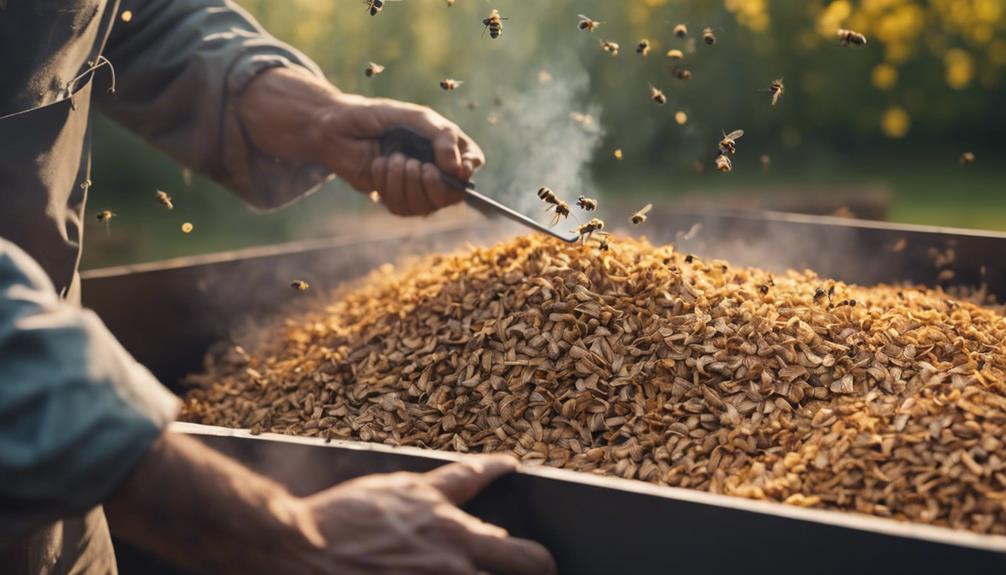
Proper ventilation is crucial when working with a bee smoker. It guarantees the smoke remains cool and consistent. Without adequate airflow, the smoker’s temperature can spike, impacting the burn rate and the overall effectiveness of the tool.
Monitoring and adjusting the smoker’s ventilation openings are simple steps that can greatly enhance the beekeeping experience.
Ventilation Importance
Maintaining adequate ventilation in a bee smoker is essential for ensuring a consistent and cool smoke during hive inspections. Proper airflow is key to managing the temperature inside the smoker and effectively burning the wood chips.
Without good ventilation, the smoker can overheat, leading to quick burning of the wood chips or excessive smoke production. By controlling the airflow, beekeepers can create a calming environment for the bees and prevent any unnecessary disturbances during inspections.
Ventilation Tips
To ensure peak performance of the bee smoker, it’s vital to prioritize efficient airflow management for consistent smoke production and temperature control during hive inspections. Adequate ventilation plays a pivotal role in ensuring that the wood chips smolder evenly, producing the right amount of cool smoke for the bees.
By adjusting the smoker’s vents to regulate oxygen intake, you can influence the combustion process and maintain ideal smoke levels. This not only helps prevent excessive heat buildup but also allows for efficient fuel consumption, maximizing the use of wood chips.

Roger Thomas is a seasoned beekeeper and hive architect with a deep-seated passion for sustainable living. His fascination with bees has shaped his professional career, giving him practical and theoretical expertise in bee behavior, colony health, and optimal hive conditions. Roger’s technical skills shine in his bespoke hive creations that cater to the specific needs of diverse bee species, while his sustainable practices promote environmental balance and the wellbeing of the bee population.
As he continues his journey in beekeeping, Roger has become a dedicated advocate for responsible practices and an insightful educator in his field. His posts aim to inspire new beekeepers, underline the importance of sustainability, and showcase the remarkable contribution bees make to our ecosystem. Roger invites you to join him as he delves into the world of bees and the rewarding, honey-sweet art of beekeeping.
